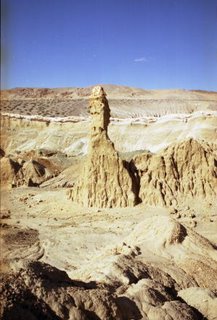
Some folks look at Nevada’s wide, open expanses and see nothing.
Those in the know look at the same landscape and see it for what it is—a biological wonderland filled with unique plants, fish, and animal life.
One of the best places in Nevada to discover the desert’s hidden life forms is Ash Meadows Wildlife Refuge, located in southwestern Nevada, about 90 miles north of Las Vegas.
The first thing you notice about Ash Meadows is that it doesn’t look much different from the rest of Southern Nevada. You see acres of gently rolling hills, occasionally populated by sagebrush, juniper trees, and mesquite bushes. But upon closer look you’ll find there’s much more to Ash Meadows.
In fact, this little pocket of rural Nevada boasts the greatest concentration of endemic species in the United States. Some 24 different species of plants, fish, and animal life are only found at Ash Meadows.
The Ash Meadows refuge, which encompasses about 22,000 acres, was originally part of a large Amargosa Valley alfalfa ranch, which was later used for cattle ranching.
In 1984, the nature conservancy purchased a portion of the ranch to prevent it from being further developed. A few years later, the area was designated a national wildlife refuge and came under the management of the U.S. Fish and Wildlife Service. In 1994, a small part of the wildlife refuge, the site of a natural area known as Devil’s Hole, was made part of the Death Valley National Park.
One of the main reasons that Ash Meadows was made into a nature preserve was because of the presence of a tiny creature known as the Devil’s Hole pupfish. This inch-long, nearly transparent fish can only be found at Devil’s Hole, which is a deep, narrow crevice in the ground that is filled with natural spring water.
This small body of water is the only place in the world that the devil’s hole pupfish proliferates. About 90 percent of this endangered species lives within 20 feet of the water’s surface and spawn on a submerged rock ledge.
Ground water usage in the surrounding Amargosa Valley is strictly regulated to ensure that the water level in Devil’s Hole doesn’t drop below the level necessary to support the pupfish population. Scientists believe the springs throughout the valley are linked so that any change in the water table, such as that caused by excessive groundwater pumping, can have an adverse effect on the pupfish.
The reason so many springs are clustered at Ash Meadows is that it is a major discharge point for a large underground aquifer, believed to stretch nearly 100 miles to the northeast. Apparently, a prominent geological fault at Ash Meadows blocks the underground flow of the aquifer and forces the water to the surface. Because this water is thought to have entered the ground thousands of years ago, it is known as “fossil water.”
The Devil’s Hole pupfish isn’t the only unique species of fish found at Ash Meadows. On the refuge you can find about a half-dozen spring-fed pools, and nearly each has its own one-of-a-kind species.
For example, the Ash Meadows Amargosa Pupfish thrives in a warm water pond called crystal springs while the Warm Springs Pupfish is only found in a pond known, not surprisingly, as Warm Springs. Additionally, at Jackrabbit Spring, you’ll spot the endangered Ash Meadows speckled dace, another type of tiny fish.
Each pool is believed to have once been part of a larger body of water that eventually receded into smaller, separate ponds. Over time, subgroups of pupfish evolved, each genetically different from the others.
Walking through the refuge is a peaceful experience. A few hundred yards from the dirt road leading into the refuge, it’s not uncommon to spot small herds of wild horses and wild burros foraging in the area.
A short walk from the main parking area leads you to crystal spring interpretive boardwalk. This wooden walkway allows you to safely view some of the unique plants found at Ash Meadows, such as the threatened Ash Meadows Ivesia and the Ash Meadows Gumplant.
The boardwalk also provides a platform for viewing crystal spring, which is so-named because of its sparkling, inviting, clear blue waters. Standing on the grassy edge of the warm, spring-fed pond, which is about the size of a typical backyard swimming pool, you can see small bubbles rising from somewhere below.
It you look closely into the water, which is about 85 degrees, you can see the tiny pupfish swimming around a submerged rock ledge, looking like tiny, silvery, nearly see-through sardines. It is kind of humbling to look at these little fish darting through the water and realize that they represent all the members of their particular species in the entire world.
Ash Meadows is home to seven species of plants that are either endangered or threatened, including the Amargosa niterwort, the Ash Meadows milk-vetch, and the Ash Meadows sunray. The Ash Meadows naucorid, a water-based beetle, is also on the list of threatened insects.
239 different species of birds have been sited at the refuge, including endangered falcons and bald eagles, which makes it popular for bird watching the best time of year to spot birds is during the spring and fall migrations.
Among the remnants of the old cattle ranch that was once on the site of the refuge are two large, manmade lakes, fed by overflow from some of the springs. At one of them, Crystal Lake, swimming is allowed.
The long-term goal of the wildlife service is to remove any unnecessary roads and buildings as well as the more than 100 non-native plants and animals that were introduced into the region by past development.
For more information about the Ash Meadows National Wildlife Refuge, call 775-372-5435.










